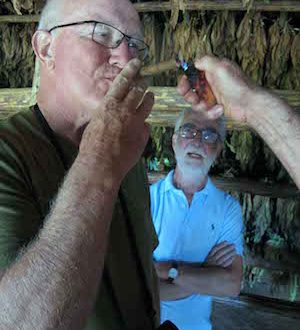 Our Cuban Holiday Part Two:
Our Cuban Holiday Part Two:
We were on a mission today. Cindi had promised to procure some cigars for her vicar. And we planned to bring a few back for our future son in law who has given up smoking but relishes a very occasional puff on a good cigar.
Hustlers try to sell tourists cheap cigars on the streets of Havana filled with tobacco scraps or even floor sweepings. But we wanted good cigars so were keen to go to the scenic Vinales valley where much of Cuba’s tobacco is grown. Although the farmers have to sell 80 percent of their crops to the government they can do what they like with the remainder. Many of the tobacco farms have therefore opened their doors to tourists to make some additional income from selling cigars.
It was a long and dreary drive through a scrubby and unpeopled landscape. We couldn’t help wondering why, as Cuba has to import so much of its food (70 percent) some of this land could not be cultivated.
But as we approached the Vinales valley the landscape changed dramatically and became greener and more mountainous.
Here unusual steep sided hills with rounded tops called mogote rise steeply from the valley floor.
Before heading off to the tobacco fields we made a cave visit. Unfortunately several busloads of tourists had arrived before us so we had to wait for ages at the entrance of the cave. Once in we found ourselves in a dark limestone cave (much smaller and not as impressive as Waitomo and no glow worms!) with a very short boat ride at the end. We rather regretted that we had chosen to spend time doing this activity.
The rest of the day proved much more interesting. We went to view the Mural de la Prehistoria , a rock painting which traces the story of life from mollusks, to dinosaurs and early humans. This massive and colourful piece of neo cave art (120 metres long) was designed by Leovigildo Gonzales Morilla, a follower of the famous Mexican mural painter Diego Riviera and took four years to complete with the help of some of the locals.
Lunch was available in a large restaurant nearby but to avoid the hordes of tourists Yaniet suggested that we lunch at a smaller and more intimate one not too far away. It was a great choice as there we enjoyed a traditional Cuban feast of pork, seafood, lightly spiced and aromatic rice, beans, baked plantains and salad.
Afterwards we drove further into the Vinales Valley, happy to be in the lush green countryside. The Vinales valley was designated as a World Heritage site in 1999 by Unesco as a cultural landscape as old-fashioned farming methods and equipment are still used to grow tobacco and it retains the traditional village architecture.
On the farm we visited the owner was absent, but after being offered a small complimentary cup of coffee the foreman showed us around. We walked around the fields where tobacco plants were growing at various stages before heading to an old barn which was well ventilated. Here tobacco leaves were strung from the ceiling to dry before being fermented to develop their flavour and aroma.
The foreman sat down on a stool and expertly explained the intricacies of how to roll a cigar using about 6 tightly rolled leaves. When he lit it the smell was somewhere between acrid and enticing,
All four of us are non- smokers but as you do in Cuba we could not resist a puff or two before handing it back to him to finish.
Yaniet confided in us that she knew of a better place to buy our cigars. So we headed to a smaller farm where cigars were available in 3 sizes. They were priced in a novel way (if you purchased a bundle of 23 they would give you a free one which would make it two dozen ).We bought the large ones between us but as they were unlabelled and unboxed our mission was not yet complete.
So the following morning we headed for a large indoor market in Havana where there were plenty of bamboo cigar tubes, on many of which the heroic face of Che Guevara was printed.
Che, I later discovered, despite being an asthmatic, was addicted to Cuban cigars. There are many photographs of him both with a cigar in his mouth and one in his pocket. Not surprisingly he eventually developed pulmonary emphysema but despite medical advice could never entirely overcome his addiction. However it was not his illness which killed the heroic Che. He was eventually captured and executed.
Our Cuban cigars, each securely packed in an individual bamboo tube, travelled safely home with us.
By Lyn Potter. Read more here.










Join the Discussion
Type out your comment here:
You must be logged in to post a comment.